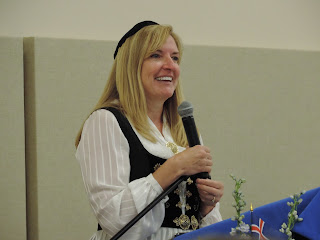Five hundred years have now passed since that seminal moment on
October 31, 1517, when legend says Martin Luther posted what came to be called the
Ninety-five Theses on the door of the castle church in Wittenberg, Saxony, a
town of fewer than five thousand souls at the time. Although some historians
have disputed the details of the story that has grown up around that event,
there can be no dispute that what unfolded in the aftermath was one of the most
dramatic stories in human history. Whatever else happened that day, it is
certain that Luther wrote a letter to his superiors denouncing the sale of
indulgences and soliciting their repayment, to which he appended his now famous
theses (that is to say, propositions) on the subject. This act of conscience led
directly to the Protestant Reformation, a religious transformation that reached
the shores of distant Iceland some twenty years later.
 |
| Martin Luther in Wittenberg (Photo - Andreas Breitling / Pixabay) |
Indulgences were thought to be a means to reduce the punishment one
would have to undergo in the afterlife because of one’s sins in this life. They
also happened to be an important source of revenue for the church. Luther found
the practice repugnant, having come to the view that forgiveness came through
God’s grace, not the purchase of others’ surplus merit.
Luther had already been preaching against indulgences and other
corruptions of the church, so the content of his theses was hardly news.
However, this event did mark a turning point and has since been reckoned as the
beginning of the Reformation. Luther shared his theses with a few bishops and
friends, they were published using the relatively new technology of printing,
and they subsequently came to the attention of the Pope, who directed his
bishop to rein in the protesting monk.
At the Diet of Worms in 1521, where Luther had been summoned to defend
his position, he declared: “Unless I am convinced by scripture and plain reason –
I do not accept the authority of the popes and councils, for they have
contradicted each other – my conscience is captive to the Word of God. I cannot
and I will not recant anything for to go against conscience is neither right
nor safe. God help me. Amen.” Although this differs from the common paraphrase
of his words – “Here I stand; I can do no other” – it was an equally powerful
moral statement and a measure of his courage in a moment of great threat to his
own wellbeing.
When Luther left the room,
he said, “I am finished,” which seemed obvious to everyone, and he was granted
three weeks’ safe conduct to return home, where it was expected he would face
the common fate that awaited heretics in that day. Following his departure from
Wörms in the company of the nobles who supported him, the emperor declared
Luther an outlaw, but Elector Friedrich the Wise staged a kidnapping and Luther
was whisked away to safety in the castle at Wartburg, perched high above the
town of Eisenach, where he lived incognito as Junker Jörg (George the knight)
for nearly a year. While there, Luther translated the New Testament into
German, a task he accomplished in just eleven weeks.
As it turned out, Luther was nowhere near
finished. Indeed, history makes it clear that he had only just begun. By the
time he returned to Wittenberg, the Reformation was well underway, forever
changing the face of Christendom.




